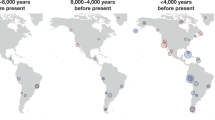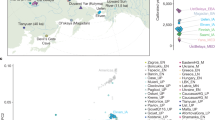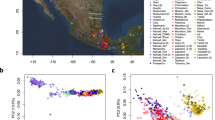Abstract
Palaentology and archaeology are disciplines that traditionally deal with the reconstruction of human origins and history. Recently, however, molecular genetics has come to make increasing contributions to this area. In particular, several data sets indicate that variation of the human gene pool originated in Africa within the last 200,000 years. Furthermore, the study of DNA sequences allows the detection of expansions in population size. Here we briefly summarize and exemplify how DNA sequences can be used to reconstruct the history of populations.
This is a preview of subscription content, access via your institution
Access options
Subscribe to this journal
Receive 12 print issues and online access
$209.00 per year
only $17.42 per issue
Buy this article
- Purchase on Springer Link
- Instant access to full article PDF
Prices may be subject to local taxes which are calculated during checkout
Similar content being viewed by others
References
Slatkin, M. & Hudson, D. Pairwise comparisons of mitochondrial DNA sequences in stable and exponentially growing populations. Genetics 129, 555–562 (1991).
Majoram, P. & Donnelly, P. Pairwise comparisons of mitochondrial DNA sequences in subdivided populations and implications for early human evolution. Genetics 136, 673–683 (1994).
Rogers, A. Genetic evidence for a Pleistocene population explosion. Evolution 49, 608–615 (1995).
Cann, R.L., Stoneking, M. & Wilson, A.C. Mitochondrial DNA and human populations. Nature 325, 31–36 (1987).
Vigilant, L., Stoneking, M., Harpending, H., Hawkes, K. & Wilson, A.C. African populations and the evolution of human mitochondrial DNA. Science 253, 1503–1507 (1991).
Ruvolo, M. et al. Mitochondrial COII sequences and modern human origins. Mol. Biol. Evol. 10, 1115–1135 (1993).
Horai, S., Hayasaka, K., Kondo, R., Tsugane, K. & Takahata, N. Recent African origin of modern humans revealed by complete sequences of hominoid mitochondrial DNAs. Proc. Natl. Acad. Sci. USA 92, 532–536 (1995).
Stoneking, M., Sherry, S.T., Redd, A.J. & Vigilant, L. New approaches to dating suggest a recent age for the human mtDNA ancestor. Phil. Trans. R. Soc. Lond. B 337, 167–175 (1992).
Pesole, G., Sbisa, E., Preparata, G. & Saccone, C. The evolution of the mitochondrial D-loop region and the origin of modern man. Mol. Biol. Evol. 9, 587–598 (1992).
Wills, C. When did Eve live? An evolutionary detective story. Evolution 49, 593–607 (1995).
Dorit, R.L., Akashi, H. & Gilbert, W. Absence of polymorphism at the ZFY locus on the human Y chromosome. Science 268, 1183–1185 (1995).
Weiss, G. & von Haeseler, A. How many Ys? Science 272, 1358–1360 (1996).
Hammer, M.F. A recent common ancestry for human Y chromosomes. Nature 378, 376–378 (1995).
Fu, Y.-X. & Li, W.-H. The age of the common ancestor of human Y chromosomes. Nature (in the press).
Takahata, N. Allelic genealogy and human evolution. Mol Biol. Evol. 10, 2–22 (1993).
Morin, P.A. et al. Kin selection, social structure, gene flow and the evolution of chimpanzees. Science 265, 1193–1201 (1994).
Ferris, S.D., Brown, W.M., Davidson, W.S. & Wilson, A.C. Extensive polymorphism in the mitochondrial DNA of apes. Proc. Natl. Acad. Sci. USA 78, 6319–6323 (1991).
Ruvolo, M. et al. Gene trees and hominoid phylogeny. Proc. Natl. Acad. Sci. USA 91, 8900–8904 (1994).
Blanchard, J.L. & Schmidt, G.W. Mitochondrial DNA migration events in yeast and humans: Integration by a common end-joining mechanism and alternative perspectives on nucleotide substitution patterns. Mol. Biol. Evol. 13, 537–548 (1996).
Crouau-Roy, B., Service, S., Slatkin, M. & Freimer, N. A fine-scale comparison of the human and chimpanzee genomes: linkage, linkage disequilibrium and sequence analysis. Hum. Mol. Genet. 8, 1131–1137 (1996).
Nei, M. & Graur, D. Extent of protein polymorphism and the neutral mutation theory. Evol. Biol. 17, 73–118 (1984).
Li, W.H. & Sadler, L.A. Low nucleotide diversity in man. Genetics 129, 513–523 (1991).
Hedrick, P. Evolutionary genetics of the major histocompatibility complex. Am. Naturalist 143, 945–964 (1994).
Gyllensten, U.B., Sundvall, M. & Erlich, H.A. Alielic diversity is generated by intraexon exchange at the DRB1 locus of primates. Proc. Natl. Acad. Sci. USA 88, 3686–3690 (1991).
Takahata, N., Satta, Y. & Klein, J. Polymorphism and balancing selection at major histocompatibility complex loci. Genetics 130, 925–938 (1992).
Ayala, F.J. The myth of Eve: molecular biology and human origins. Science 270, 1930–1936 (1995).
Ayala, F.J. & Escalante, A.A. The evolution of human populations: A molecular perspective. Mol. Phyl. Evol. 5, 188–201 (1996).
Titus-Trachtenberg, E.A., Rickards, O., De Stefano, G.F. & Erlich, H.A. Analysis of HLA class II haplotypes in the Cayapa Indians of Ecuador: A novel DRBI allele reveals evidence of convergent evolution and balancing selection at position 86. Am. J. Hum. Genet. 55, 160–167 (1994).
Gustafsson, K. et al. Structure of miniature swine class II DRB genes: conservation of hypervariable amino acid residues between distantly related species. Proc. Natl. Acad. Sci. USA 87, 9798–9802 (1990).
Gustafsson, K. & Andersson, L. Structure and polymorphism of horse MHC class II DRB genes: convergent evolution in the antigen binding site. Immunogenet. 39, 355–358 (1994).
Maddison, D.R. African origin of human mitochondrial DNA reexamined. Syst. Zool. 40, 355–363 (1991).
Templeton, A.L. Human origins and analysis of mitochondrial DNA sequences. Science 255, 737 (1992).
Hedges, S.B., Kumar, S., Tamura, K. & Stoneking, M. Human origins and analysis of mitochondrial DNA sequences. Science 255, 737–739 (1992).
Maddison, D.R., Ruvolo, M. & Swofford, D.L. Geographic origins of human mitochondrial DNA phylogenetic inference from control region sequences. Syst. Biol. 41, 111–124 (1992).
Penny, D., Steel, M., Waddell, P.J. & Hendy, M.D. Improved analyses of human mtDNA sequences support a recent African origin of Homo sapiens. Mol. Biol. Evol. 12, 863–882 (1995).
Strimmer, K. & von Haeseler, A. (1996) Quartet puzzling: A maximum likelihood method for reconstructing tree topologies. Mol. Biol. Evol. 13, 964–969 (1996).
D'Andrade, R. & Morin, P.A. A principal components and individual-by-site analysis of chimpanzee and human mitochondrial DNA. Am. Anthropol. 98(2), 2–20 (1996).
Zischler, H., Geisert, H., von Haeseler, A. & Pääbo, S. A nuclear “fossil” of the mitochondrial D-loop and the origin of modern humans. Nature 378, 489–492 (1995).
Wainscoat, S. et al. Evolutionary relationships of human populations from an analysis of nuclear DNA polymorphisms. Nature 319, 491–493 (1986).
Tishkoff, S.A. et al. Global patterns of linkage disequilibrium at the CD4 locus and modern human origins. Science 271, 1380–1387 (1996).
Manderscheid, E.J. & Rogers, A.R. Genetic admixture in the late Pleistocene. Am. J. Phys. Anthropol. (in the press).
Nei, M. & Takezaki, N. The root of the phylogenetic tree of human populations. Mol. Biol. Evol. 13, 170–177 (1996).
Goldstein, D.B., Linares, A.R., Cavalli-Sforza, L.L. & Feldman, M.W. Genetic absolute dating based on microsatellites and the origin of modern humans. Proc. Natl. Acad. Sci. USA 92, 6723–6727 (1995).
Tishkoff, S.A. et al. A global haplotype analysis of mytonic dystrophy CTG-repeats in humans and other primates. Am. J. Hum. Genet. 57, A42 (1995).
Armour, J.A.L. et al. Minisatellite diversity supports a recent African origin for modern humans. Nature Genet. 13, 154–160 (1996).
Sajantila, A. et al. Genes and languages in Europe: an analysis of mitochondrial lineages. Genome Res. 5, 42–52 (1995).
Sajantila, A. & Pääbo, S. Language replacement in Scandinavia. Nature Genet. 11, 359–360 (1995).
Mountain, J.L., Hebert, J.M., Bhattacharyya, S., Underhill, P.A., Ottolenghi, C., Gadgil, M. & Cavalli-Sforza, L.L. Demographic history of India and mtDNA-sequence diversity. Am. J. Hum. Genet. 56, 979–992 (1995).
Watson, L., Bauer, K., Aman, R., Weiss, G., von Haeseler, A. & Pääbo, S. MtDNA sequence diversity in Africa. Am. J. Hum. Gen. 59, 437–444 (1996).
Cavalli-Sforza, L.L. & Ammermann, A. The neolithic transition and the genetics of populations in Europe. (Princeton University Press, 1984).
Rogers, A. & Harpendinger, H. Population growth makes waves in the distribution of pairwise genetic differences. Mol. Biol. Evol. 9, 552–569 (1992).
Sherry, S.T. et al. Mismatch distributions of mtDNA reveal recent human population expansions. Hum. Biol. 66, 761–775 (1994).
Ivanov, P.L. et al. Mitochondrial sequence heteroplasmy in the Grand Duke of Russia Georgij Romanov establishes the authenticity of the remains of Tsar Nicholas II. Nature Genet. 12, 417–420 (1996).
Howell, N., Kubacka, I. & Mackey, D.A. How rapidly does the human mitochondrial genome evolve? Am. J. Hum. Genet. 59, 501–509 (1996).
Pääbo, S. Mutations in the mitochondrial microcosm. Am. J. Hum. Genet. 59, 493–496 (1996).
Sajantila, A. et al. Mitochondrial and Y chromosome lineage analyses reveal founder effect in the Finnish population. Proc. Natl. Acad. Sci. USA, (in the press).
Richards, M. et al. Paleolithic and neolithic lineages in the European mitochondrial gene pool. Am. J. Hum. Genet. 59, 185–203 (1996).
Felsenstein, J., Phylogenitic Inference Programs (PHYLIP), University of Washington, Seattle and University Herbarium, University of California, Berkeley. (1993).
Author information
Authors and Affiliations
Corresponding author
Rights and permissions
About this article
Cite this article
Haeseler, A., Sajantila, A. & Pääbo, S. The genetical archaeology of the human genome. Nat Genet 14, 135–140 (1996). https://doi.org/10.1038/ng1096-135
Issue Date:
DOI: https://doi.org/10.1038/ng1096-135
This article is cited by
-
Mitochondrial DNA can be inherited from fathers, not just mothers
Nature (2019)
-
Zur Wissenschaftsgeschichte der aDNA-Forschung
NTM Zeitschrift für Geschichte der Wissenschaften, Technik und Medizin (2017)
-
Phylogeography and genetic diversity of the Robin (Erithacus rubecula) in the Azores Islands: Evidence of a recent colonisation
Journal of Ornithology (2013)
-
Genetic markers and population history: Finland revisited
European Journal of Human Genetics (2009)
-
Conservation genetics in hypersaline inland waters: mitochondrial diversity and phylogeography of an endangered Iberian beetle (Coleoptera: Hydraenidae)
Conservation Genetics (2006)



